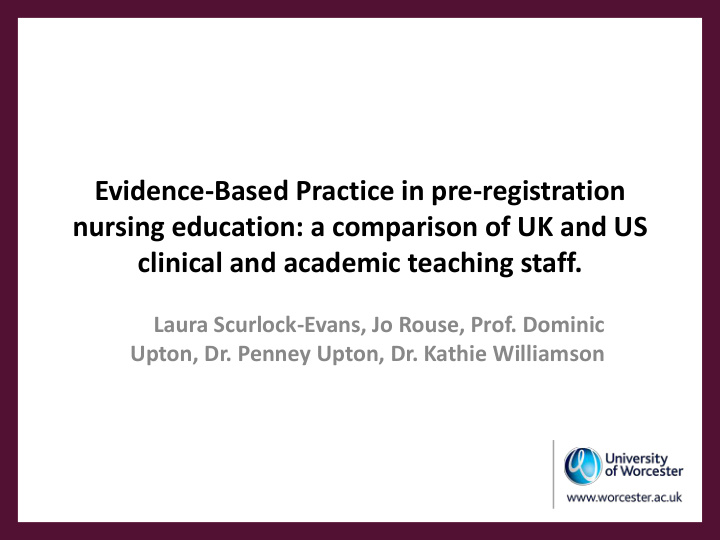



Evidence-Based Practice in pre-registration nursing education: a comparison of UK and US clinical and academic teaching staff. Laura Scurlock-Evans, Jo Rouse, Prof. Dominic Upton, Dr. Penney Upton, Dr. Kathie Williamson
Background Evidence-Based Practice (EBP) “Evidence -based practice within nursing is achieved by developing and supporting patient-centred approaches to care using the most current evidence.” (Emanuel et al., 2011; p.1) Impact on policy NHS plan (Department of Health, 2000), Service Frameworks (DH, 2001), clinical practice guidelines (Grinspun et al. 2002). State Medicaid policy changes (AHRQ, 2012), Health Professions Education: A Bridge to Quality report (Institute of Medicine, 2003), Changes to Pre-reg nursing in the UK – Nursing and Midwifery Council (2010), Quality and Safety Education for Nurses (QSEN) – US initiative
The study Approach Online survey (US & UK versions) – including the Evidence-Based Practice Questionnaire (EBPQ; Upton & Upton, 2006). 8 weeks – reminder email Closed and open-ended questions Sample Quantitative N=81 Country Academic Clinical Total context context UK 9 43 52 US 12 17 29 Total 21 60 81
Quantitative findings Country of practice No significant differences Context of practice Significant difference between Academic & clinical staff on EBP knowledge/skills (small effect) Interaction? No interactions
The study Sample Qualitative N=82 Country Academic Clinical Total context context UK 10 43 53 US 11 18 29 Total 21 61 82
Qualitative findings of barriers Five main categories: Evidence-related issues Organisational issues Teaching-related issues Skills-related issues No barriers
Qualitative findings – barriers to teaching EBP “some of the evidence itself being conducted on small groups in very specific arenas..” (Participant 46) “poor communication of research to clinical faculty or bedside nurse” (Participant 44) "...Difficult to do much of keeping up with laundry some days let alone literature and practice with a very busy workload and large number of students." (Participant 55).
Qualitative findings – barriers to teaching EBP "At times it feels as if we are detached from the academic side of nursing and do not have opportunity or time to fully update on current EBP or other good practice" (Participant 3). "Sometimes the students feel it's rather boring and pointless but when we point out how treatments have advanced over the years due to EBP and are able to give and show examples they quickly understand its value." (Participant 47).
Conclusions Similar patterns of EBP Use, Attitudes and Knowledge/skills across US/US, clinical/academic Similar qualitative barriers between US and UK Slight differences between academic and clinical barriers identified Implications Greater cohesion between clinical and academic contexts needed Mechanisms to help educators be confident their knowledge and skills are current need to be explored
Questions?
Recommend
More recommend